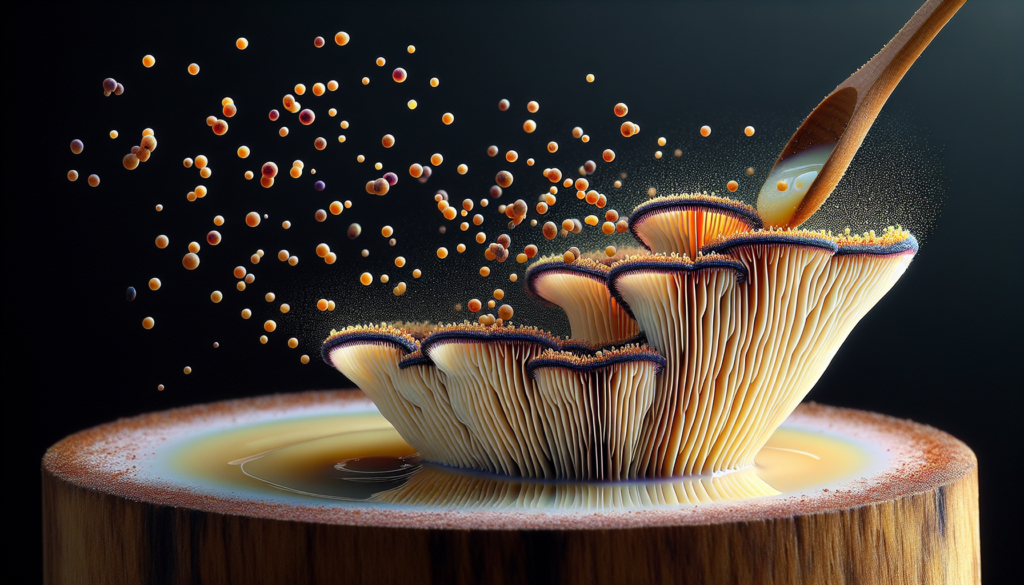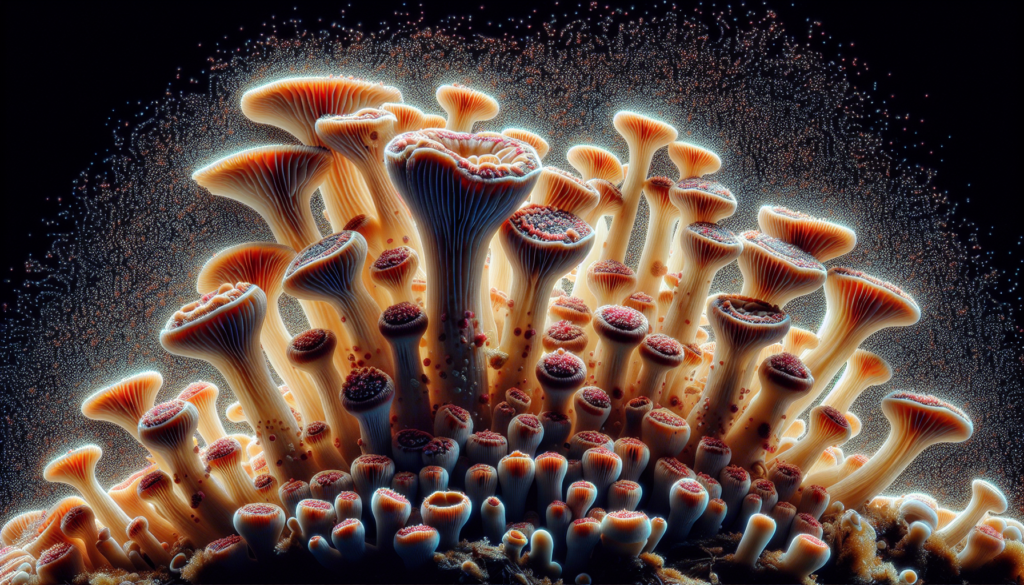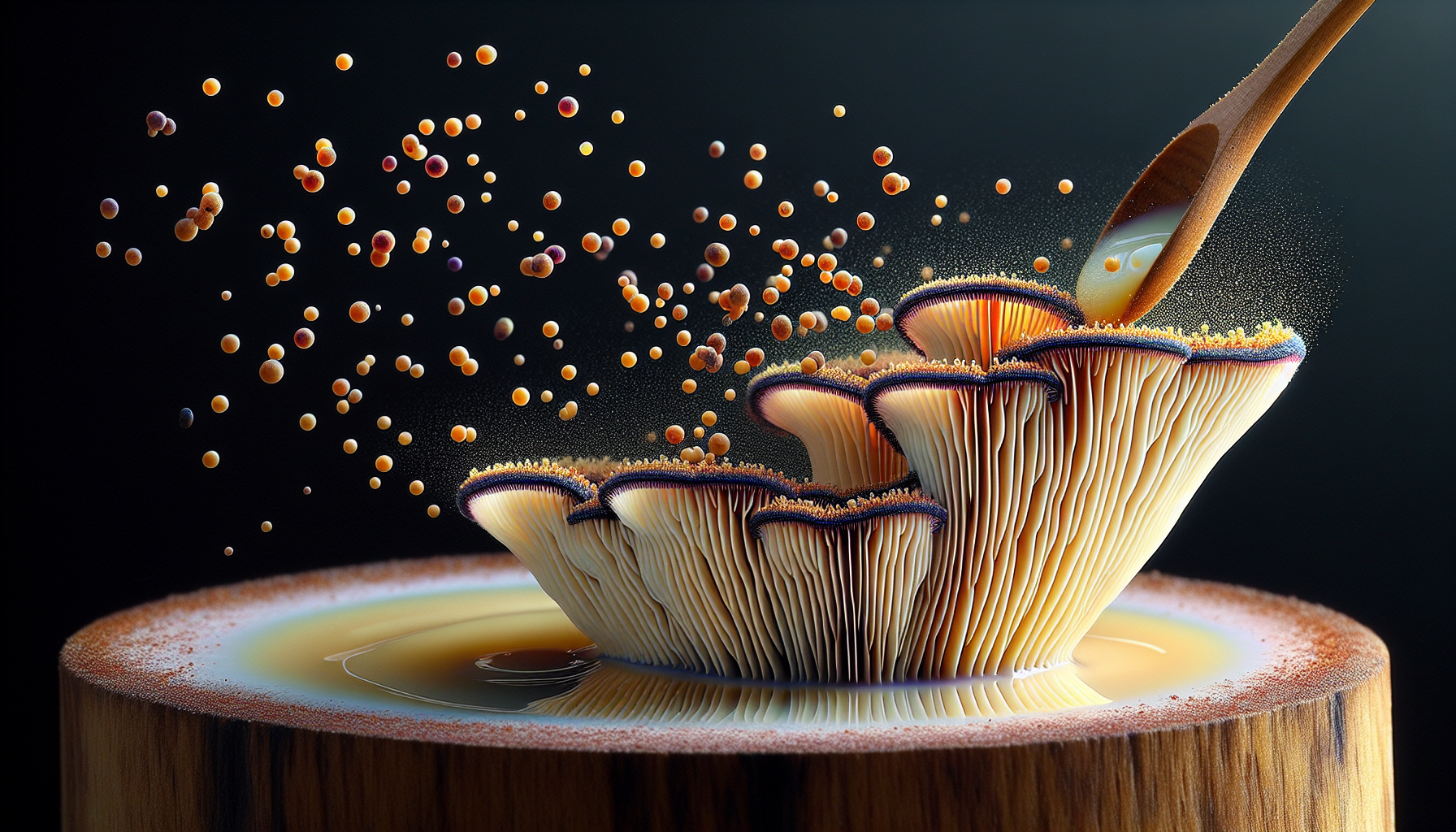Imagine stumbling upon a mysterious mushroom during a leisurely stroll through the woods. Instantly captivated by its vibrant color and intricate design, you’re struck with curiosity about its identity. How can you unravel the enigma of this intriguing fungi? Enter the fascinating world of spore prints, a key tool used by mushroom enthusiasts and mycologists to decipher the identity of mushrooms. By extracting the spores, these delicate dust-like particles produced by mushrooms, and examining their color and pattern, a spore print can unveil crucial details that help identify the species. So, let’s embark on a journey to explore this unique method of identification and unlock the secrets of the hidden realm beneath the mushroom cap.
What is a spore print?
A spore print is a method used to identify mushrooms and fungi based on the color and characteristics of their spores. When a mushroom releases spores, they fall onto a surface and create a unique pattern, known as a spore print. This print can provide valuable information about the mushroom, such as its species and sometimes even its genus. Spore prints are commonly used by mycologists, mushroom enthusiasts, and researchers to identify and classify various species of fungi.
Definition of a spore print
A spore print is the collection of spores released by a mushroom or fungi. It is created by placing the cap of a mature mushroom, gills facing downward, on a piece of paper or glass. As the mushroom releases spores, they fall onto the surface below, forming a visible pattern. This pattern, along with the color and other characteristics of the spores, is examined and compared to existing identification keys and resources to determine the species of the mushroom.
Process of creating a spore print
Creating a spore print involves a few simple steps. First, a mushroom with mature spores is selected. The cap is carefully detached from the stem, ensuring that the gills remain intact and face downwards. The cap is then placed on a clean piece of paper or glass, with the gills directly touching the surface. The mushroom is left undisturbed for several hours or overnight to allow the spores to fall and create the print. The spore print can then be examined and analyzed.
Why are spore prints used for identification?
Spore prints are widely used for the identification of mushrooms and fungi due to several reasons.
Importance of spore prints in identification
Spore prints provide a crucial piece of information in the identification process. Each species of mushroom has its own distinct spore color and pattern, which can help differentiate it from other similar-looking mushrooms. By comparing the characteristics of a spore print to existing databases, field guides, and identification keys, one can narrow down the possibilities and determine the likely species of a mushroom.
Advantages of using spore prints
There are several advantages to using spore prints in mushroom identification. Firstly, spore prints can be obtained relatively easily and quickly. With just a mushroom cap and a piece of paper or glass, one can create a spore print within hours. Additionally, spore prints provide a clear and visible representation of the spores, making it easier to compare and analyze their color, shape, and pattern. This visual information can be especially helpful for beginners or individuals who are not familiar with the microscopic examination of spores.
Limitations of using spore prints
While spore prints are a valuable tool in mushroom identification, they do have some limitations. Firstly, spore prints can only provide information about the spores themselves and not other characteristics of the mushroom, such as its smell or taste. Therefore, they should be used in conjunction with other identification methods to ensure accurate results. Additionally, some species may have spore colors that vary within the same species or overlap with other species, making identification solely based on spore prints challenging. It is important to consider other factors such as the habitat, macroscopic features, and biology of the mushroom for a comprehensive identification.

How to obtain a spore print
Obtaining a spore print requires proper selection and preparation of the mushroom.
Choosing the right mushroom for spore printing
To obtain a reliable spore print, it is crucial to select a mature mushroom with well-developed gills and visible spores. Avoid selecting mushrooms that are too young or have not yet released their spores, as this will result in an insufficient or inaccurate print. Choose mushrooms that are in good condition and free from decay or damage to ensure a clear and reliable outcome.
Preparing the mushroom cap for spore printing
Once you have chosen a suitable mushroom, gently remove the stem, ensuring the gills remain intact with the cap. It is important to handle the mushroom with care to avoid damaging the gills or releasing spores prematurely. Place the cap with the gills facing downward on a clean piece of paper or glass. This will allow the spores to fall and create a clear and visible print.
Creating the spore print
After placing the mushroom cap on the paper or glass, it is best to cover it with a glass or bowl. This will help maintain a humid environment, promoting the release of spores. Leave the mushroom undisturbed for several hours or overnight to ensure ample time for the spores to fall and create a distinct print. Once the desired time has passed, carefully lift the cap and examine the spore print.
Interpreting and analyzing spore prints
To make the most of a spore print’s information, it is essential to analyze and interpret the various characteristics of the print.
Color of spore prints
The color of a spore print is one of the most important factors in identification. Different species of mushrooms have spores that range in color from white, cream, yellow, brown, black, or even purple. By comparing the color of the spore print to known color charts or descriptions, one can narrow down the potential species. It is worth noting that spore color can be affected by environmental factors and age, so multiple prints or additional identification methods may be necessary for confirmation.
Shape and size of spore prints
Spore prints can vary in shape and size, depending on the species of mushroom. Some prints may appear round or elliptical, while others may be irregular or elongated. Determining the shape and size of the spore print can provide further insights into the mushroom’s identity and can be compared to existing data for more accurate identification.
Texture and pattern of spore prints
In addition to color, the texture and pattern of a spore print can also be useful in identification. Some spore prints may have a smooth or finely granulated texture, while others may appear rough or with visible ridges. The pattern of the spore print, such as concentric circles or radial lines, can also vary among species. These characteristics can be observed and compared to reference materials to aid in identification.

Comparing spore prints with identification keys
Identification keys are valuable resources that help determine the species of mushrooms based on various characteristics. While spore prints are an essential component of identification, they are often used in conjunction with identification keys for more accurate results.
Understanding identification keys
Identification keys are systematic guides that provide descriptions and characteristics of different mushroom species. These keys are typically organized into a series of choices or steps, with each step leading to a more specific identification. By answering questions or observing specific features, the user can narrow down the possibilities and identify the likely species. Spore prints can be one of the steps in an identification key, and their color, shape, and other characteristics can help confirm or eliminate potential matches.
Using spore prints to narrow down possibilities
Spore prints can be particularly useful in narrowing down the choices in an identification key. By comparing the spore color, shape, and other characteristics to the descriptions in the key, one can eliminate species that do not match the observed spore print. This process helps streamline the identification process and leads to a more accurate result.
Confirming identification using other characteristics
While spore prints are informative, they should not be solely relied upon for identification. Other macroscopic features such as the shape, color, and size of the mushroom, as well as its habitat and smell, play a crucial role in confirming the identification. By carefully considering a combination of characteristics, the identification can be further validated and increase the certainty of the spore print’s accuracy.
Common mistakes to avoid when using spore prints
To ensure accurate identification, it is important to be aware of common mistakes that can occur when using spore prints.
Collecting spores incorrectly
One common mistake is collecting spores incorrectly. It is important to handle the mushroom with care to avoid prematurely releasing spores or damaging the gills. Ensure that the gills are fully intact and not disrupted before placing the cap on the paper or glass for spore printing. Mishandling the mushroom can lead to inaccurate or incomplete spore prints, making identification more challenging.
Misinterpreting spore prints
Another mistake is misinterpreting spore prints. It is essential to assess spore prints under proper lighting and lighting conditions, as the color and texture can be influenced by different lighting angles. Additionally, a keen eye and attention to detail are necessary to accurately interpret the color, shape, and pattern of the spore print. Comparing the spore print to reliable references and seeking expert advice can help avoid misinterpretation.
Relying solely on spore print color
While spore print color is an essential characteristic, it should not be the sole factor in identification. Some species may have similar spore print colors, making it necessary to consider other features such as shape, size, texture, and other macroscopic characteristics. Relying solely on spore print color can lead to misidentifications, so it is crucial to consider the entire range of characteristics when identifying a mushroom.
Alternative methods of mushroom identification
While spore prints are widely used, there are alternative methods of mushroom identification that can provide additional insights and clarification.
DNA analysis
DNA analysis is an advanced and highly accurate method of identification. It involves extracting the DNA from the mushroom and comparing it to DNA sequences in databases. DNA analysis can provide precise species identification, especially in cases where the morphology or characteristics of the mushroom are ambiguous or closely resemble other species. However, this method requires specialized equipment and expertise, making it less accessible for casual identification purposes.
Chemical tests
Chemical tests involve applying certain reagents or solutions to different parts of the mushroom to observe color changes or reactions. These tests can help identify specific chemical compounds present in the mushroom, which may be indicative of certain species. For example, some mushrooms may produce distinct color changes when exposed to specific chemicals. Chemical tests can be a valuable tool in conjunction with other identification methods, providing additional evidence for accurate identification.
Microscopic examination
Microscopic examination involves analyzing spores, fruiting bodies, and other microscopic features of the mushroom under a microscope. This method can provide detailed insights into the size, shape, ornamentation, and other characteristics of the spores, as well as the presence of specific structures such as cystidia or spore-bearing cells. Microscopic examination requires a microscope and knowledge of mycology, making it more suitable for experienced mycologists or individuals with specialized training.
Practical applications of spore prints
Spore prints have various practical applications beyond identification, making them valuable in different fields.
Ecological studies
Spore prints play a crucial role in ecological studies, as they can indicate the presence and diversity of different mushroom species in an ecosystem. By collecting and analyzing spore prints from various locations, researchers can gain insights into the distribution, abundance, and trends of mushrooms in specific habitats. This data can contribute to understanding the ecological roles of fungi and their interactions with other organisms in the environment.
Culinary use
Spore prints are also used in the culinary world to identify and select mushrooms with desirable flavors and textures. Edible mushrooms often have distinct spore prints that can help differentiate them from toxic or inedible species. By determining the spore color and comparing it to reliable resources, chefs and enthusiasts can confidently identify and utilize mushrooms for cooking, ensuring a safe and enjoyable culinary experience.
Medicinal use
Certain mushrooms have medicinal properties and are used in traditional medicine and modern pharmaceuticals. Spore prints can assist in the accurate identification of these medicinal species, ensuring the correct species is harvested and utilized. Through spore prints, researchers can also track and document the distribution of medicinal mushroom species, contributing to the development of sustainable practices for their cultivation, conservation, and therapeutic use.
Safety precautions when handling spore prints
Handling spore prints requires certain safety precautions to ensure personal well-being and prevent any potential harm.
Avoiding contact with toxic or unknown mushrooms
It is vital to exercise caution when selecting mushrooms for spore printing to avoid toxic or poisonous species. Only work with mushrooms that are positively identified as safe or familiar to you. If you are uncertain about a mushroom’s identity, it is best to refrain from handling it or seek the assistance of an experienced mycologist. Avoid contact with the mouth, eyes, or open wounds while handling mushrooms, as some species can cause irritation or allergic reactions.
Proper disposal of spore print materials
After creating a spore print, it is important to dispose of the materials properly. Spore prints can contain vast quantities of microscopic spores, which can be harmful if released into the environment or inhaled. Seal the spore print materials in a plastic bag and dispose of them in designated waste bins or areas. This prevents accidental dissemination of spores, reducing the risk of unintended contamination or health hazards.
Wearing protective gear when handling spore prints
To ensure personal safety, it is advisable to wear protective gear when handling spore prints. This includes gloves, a face mask, and goggles, particularly when working with spore prints that may contain toxic or allergenic spores. Protective gear serves as a barrier against potential harm from the mushroom’s spores, reducing the risk of skin contact, inhalation, or eye irritation.
Conclusion
Spore prints are a valuable tool in the identification and study of mushrooms and fungi. They provide essential information about the color, shape, and other characteristics of a mushroom’s spores, aiding in species identification. While spore prints have their limitations and should not be solely relied upon, they serve as a crucial piece of the puzzle in conjunction with other identification methods. By understanding the process of obtaining, interpreting, and analyzing spore prints, individuals can confidently explore the vast and fascinating world of mushrooms, whether for scientific, culinary, or medicinal purposes.


No Responses